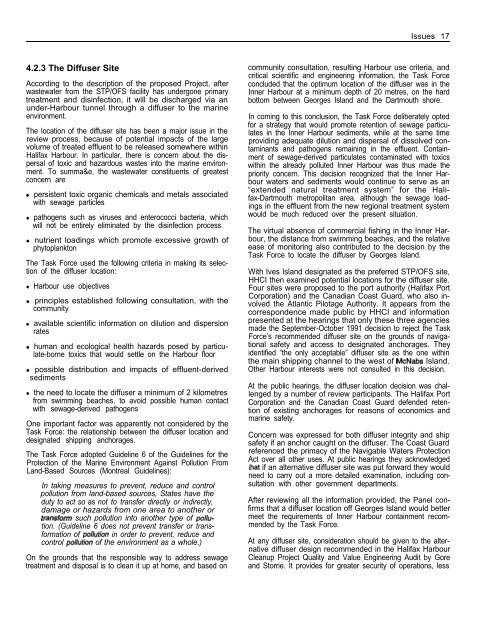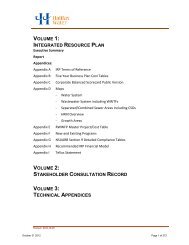Halifax Harbour Cleanup Inc. - Halifax Regional Municipality
Halifax Harbour Cleanup Inc. - Halifax Regional Municipality
Halifax Harbour Cleanup Inc. - Halifax Regional Municipality
Create successful ePaper yourself
Turn your PDF publications into a flip-book with our unique Google optimized e-Paper software.
Issues 17<br />
4.2.3 The Diffuser Site<br />
According to the description of the proposed Project, after<br />
wastewater from the STP/OFS facility has undergone primary<br />
treatment and disinfection, it will be discharged via an<br />
under-<strong>Harbour</strong> tunnel through a diffuser to the marine<br />
environment.<br />
The location of the diffuser site has been a major issue in the<br />
review process, because of potential impacts of the large<br />
volume of treated effluent to be released somewhere within<br />
<strong>Halifax</strong> <strong>Harbour</strong>. In particular, there is concern about the dispersal<br />
of toxic and hazardous wastes into the marine environment.<br />
To summa&e, the wastewater constituents of greatest<br />
concern are<br />
• persistent toxic organic chemicals and metals associated<br />
with sewage particles<br />
• pathogens such as viruses and enterococci bacteria, which<br />
will not be entirely eliminated by the disinfection process<br />
• nutrient loadings which promote excessive growth of<br />
phytoplankton<br />
The Task Force used the following criteria in making its selection<br />
of the diffuser location:<br />
• <strong>Harbour</strong> use objectives<br />
• principles established following consultation, with the<br />
community<br />
• available scientific information on dilution and dispersion<br />
rates<br />
• human and ecological health hazards posed by particulate-borne<br />
toxics that would settle on the <strong>Harbour</strong> floor<br />
• possible distribution and impacts of effluent-derived<br />
sediments<br />
• the need to locate the diffuser a minimum of 2 kilometres<br />
from swimming beaches, to avoid possible human contact<br />
with sewage-derived pathogens<br />
One important factor was apparently not considered by the<br />
Task Force: the relationship between the diffuser location and<br />
designated shipping anchorages.<br />
The Task Force adopted Guideline 6 of the Guidelines for the<br />
Protection of the Marine Environment Against Pollution From<br />
Land-Based Sources (Montreal Guidelines):<br />
In taking measures to prevent, reduce and control<br />
pollution from land-based sources, States have the<br />
duty to act so as not to transfer directly or indirectly,<br />
damage or hazards from one area to another or<br />
transfom, such pollution into another type of pollution.<br />
(Guideline 6 does not prevent transfer or transformation<br />
of pollotion in order to prevent, reduce and<br />
control pollotion of the environment as a whole.)<br />
On the grounds that the responsible way to address sewage<br />
treatment and disposal is to clean it up at home, and based on<br />
community consultation, resulting <strong>Harbour</strong> use criteria, and<br />
critical scientific and engineering information, the Task Force<br />
concluded that the optimum location of the diffuser was in the<br />
Inner <strong>Harbour</strong> at a minimum depth of 20 metres, on the hard<br />
bottom between Georges Island and the Dartmouth shore.<br />
In coming to this conclusion, the Task Force deliberately opted<br />
for a strategy that would promote retention of sewage particulates<br />
in the Inner <strong>Harbour</strong> sediments, while at the same time<br />
providing adequate dilution and dispersal of dissolved contaminants<br />
and pathogens remaining in the effluent. Containment<br />
of sewage-derived particulates contaminated with toxics<br />
within the already polluted Inner <strong>Harbour</strong> was thus made the<br />
priority concern. This decision recognized that the Inner <strong>Harbour</strong><br />
waters and sediments would continue to serve as an<br />
“extended natural treatment system” for the <strong>Halifax</strong>-Dartmouth<br />
metropolitan area, although the sewage loadings<br />
in the effluent from the new regional treatment system<br />
would be much reduced over the present situation.<br />
The virtual absence of commercial fishing in the Inner <strong>Harbour</strong>,<br />
the distance from swimming beaches, and the relative<br />
ease of monitoring also contributed to the decision by the<br />
Task Force to locate the diffuser by Georges Island.<br />
With Ives Island designated as the preferred STP/OFS site,<br />
HHCI then examined potential locations for the diffuser site.<br />
Four sites were proposed to the port authority (<strong>Halifax</strong> Port<br />
Corporation) and the Canadian Coast Guard, who also involved<br />
the Atlantic Pilotage Authority. It appears from the<br />
correspondence made public by HHCI and information<br />
presented at the hearings that only these three agencies<br />
made the September-October 1991 decision to reject the Task<br />
Force’s recommended diffuser site on the grounds of navigational<br />
safety and access to designated anchorages. They<br />
identified “the only acceptable” diffuser site as the one within<br />
the main shipping channel to the west of McNabs Island.<br />
Other <strong>Harbour</strong> interests were not consulted in this decision.<br />
At the public hearings, the diffuser location decision was challenged<br />
by a number of review participants. The <strong>Halifax</strong> Port<br />
Corporation and the Canadian Coast Guard defended retention<br />
of existing anchorages for reasons of economics and<br />
marine safety.<br />
Concern was expressed for both diffuser integrity and ship<br />
safety if an anchor caught on the diffuser. The Coast Guard<br />
referenced the primacy of the Navigable Waters Protection<br />
Act over all other uses. At public hearings they acknowledged<br />
ihat if an alternative diffuser site was put forward they would<br />
need to carry out a more detailed examination, including consultation<br />
with other government departments.<br />
After reviewing all the information provided, the Panel confirms<br />
that a diffuser location off Georges Island would better<br />
meet the requirements of Inner <strong>Harbour</strong> containment recommended<br />
by the Task Force.<br />
At any diffuser site, consideration should be given to the alternative<br />
diffuser design recommended in the <strong>Halifax</strong> <strong>Harbour</strong><br />
<strong>Cleanup</strong> Project Quality and Value Engineering Audit by Gore<br />
and Storrie. It provides for greater security of operations, less

















